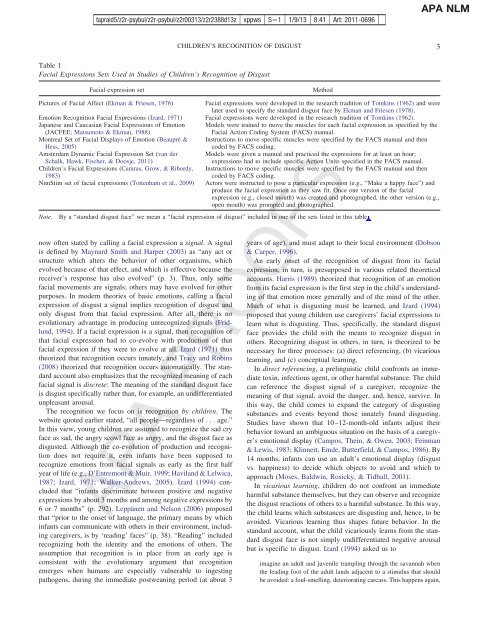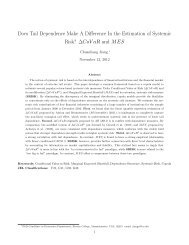Children's Recognition of Disgust in Others - Boston College
Children's Recognition of Disgust in Others - Boston College
Children's Recognition of Disgust in Others - Boston College
You also want an ePaper? Increase the reach of your titles
YUMPU automatically turns print PDFs into web optimized ePapers that Google loves.
tapraid5/z2r-psybul/z2r-psybul/z2r00313/z2r2388d13z xppws S1 1/9/13 8:41 Art: 2011-0696APA NLMCHILDREN’S RECOGNITION OF DISGUST3Table 1Facial Expressions Sets Used <strong>in</strong> Studies <strong>of</strong> Children’s <strong>Recognition</strong> <strong>of</strong> <strong>Disgust</strong>Facial expression setMethodPictures <strong>of</strong> Facial Affect (Ekman & Friesen, 1976) Facial expressions were developed <strong>in</strong> the research tradition <strong>of</strong> Tomk<strong>in</strong>s (1962) and werelater used to specify the standard disgust face by Ekman and Friesen (1978).Emotion <strong>Recognition</strong> Facial Expressions (Izard, 1971) Facial expressions were developed <strong>in</strong> the research tradition <strong>of</strong> Tomk<strong>in</strong>s (1962).Japanese and Caucasian Facial Expressions <strong>of</strong> Emotion Models were tra<strong>in</strong>ed to move the muscles for each facial expression as specified by the(JACFEE; Matsumoto & Ekman, 1988)Facial Action Cod<strong>in</strong>g System (FACS) manual.Montreal Set <strong>of</strong> Facial Displays <strong>of</strong> Emotion (Beaupré & Instructions to move specific muscles were specified by the FACS manual and thenHess, 2005)coded by FACS cod<strong>in</strong>g.Amsterdam Dynamic Facial Expression Set (van der Models were given a manual and practiced the expressions for at least an hour;Schalk, Hawk, Fischer, & Doosje, 2011)expressions had to <strong>in</strong>clude specific Action Units specified <strong>in</strong> the FACS manual.Children’s Facial Expressions (Camras, Grow, & Ribordy, Instructions to move specific muscles were specified by the FACS manual and then1983)NimStim set <strong>of</strong> facial expressions (Tottenham et al., 2009)Note.coded by FACS cod<strong>in</strong>g.Actors were <strong>in</strong>structed to pose a particular expression (e.g., “Make a happy face”) andproduce the facial expression as they saw fit. Once one version <strong>of</strong> the facialexpression (e.g., closed mouth) was created and photographed, the other version (e.g.,open mouth) was prompted and photographed.By a “standard disgust face” we mean a “facial expression <strong>of</strong> disgust” <strong>in</strong>cluded <strong>in</strong> one <strong>of</strong> the sets listed <strong>in</strong> this table.now <strong>of</strong>ten stated by call<strong>in</strong>g a facial expression a signal. A signalis def<strong>in</strong>ed by Maynard Smith and Harper (2003) as “any act orstructure which alters the behavior <strong>of</strong> other organisms, whichevolved because <strong>of</strong> that effect, and which is effective because thereceiver’s response has also evolved” (p. 3). Thus, only somefacial movements are signals; others may have evolved for otherpurposes. In modern theories <strong>of</strong> basic emotions, call<strong>in</strong>g a facialexpression <strong>of</strong> disgust a signal implies recognition <strong>of</strong> disgust andonly disgust from that facial expression. After all, there is noevolutionary advantage <strong>in</strong> produc<strong>in</strong>g unrecognized signals (Fridlund,1994). If a facial expression is a signal, then recognition <strong>of</strong>that facial expression had to co-evolve with production <strong>of</strong> thatfacial expression if they were to evolve at all. Izard (1971) thustheorized that recognition occurs <strong>in</strong>nately, and Tracy and Rob<strong>in</strong>s(2008) theorized that recognition occurs automatically. The standardaccount also emphasizes that the recognized mean<strong>in</strong>g <strong>of</strong> eachfacial signal is discrete: The mean<strong>in</strong>g <strong>of</strong> the standard disgust faceis disgust specifically rather than, for example, an undifferentiatedunpleasant arousal.The recognition we focus on is recognition by children. Thewebsite quoted earlier stated, “all people—regardless <strong>of</strong> . . . age.”In this view, young children are assumed to recognize the sad cryface as sad, the angry scowl face as angry, and the disgust face asdisgusted. Although the co-evolution <strong>of</strong> production and recognitiondoes not require it, even <strong>in</strong>fants have been supposed torecognize emotions from facial signals as early as the first halfyear <strong>of</strong> life (e.g., D’Entremont & Muir, 1999; Haviland & Lelwica,1987; Izard, 1971; Walker-Andrews, 2005). Izard (1994) concludedthat “<strong>in</strong>fants discrim<strong>in</strong>ate between positive and negativeexpressions by about 3 months and among negative expressions by6 or 7 months” (p. 292). Leppänen and Nelson (2006) proposedthat “prior to the onset <strong>of</strong> language, the primary means by which<strong>in</strong>fants can communicate with others <strong>in</strong> their environment, <strong>in</strong>clud<strong>in</strong>gcaregivers, is by ‘read<strong>in</strong>g’ faces” (p. 38). “Read<strong>in</strong>g” <strong>in</strong>cludedrecogniz<strong>in</strong>g both the identity and the emotions <strong>of</strong> others. Theassumption that recognition is <strong>in</strong> place from an early age isconsistent with the evolutionary argument that recognitionemerges when humans are especially vulnerable to <strong>in</strong>gest<strong>in</strong>gpathogens, dur<strong>in</strong>g the immediate postwean<strong>in</strong>g period (at about 3years <strong>of</strong> age), and must adapt to their local environment (Dobson& Carper, 1996).An early onset <strong>of</strong> the recognition <strong>of</strong> disgust from its facialexpression, <strong>in</strong> turn, is presupposed <strong>in</strong> various related theoreticalaccounts. Harris (1989) theorized that recognition <strong>of</strong> an emotionfrom its facial expression is the first step <strong>in</strong> the child’s understand<strong>in</strong>g<strong>of</strong> that emotion more generally and <strong>of</strong> the m<strong>in</strong>d <strong>of</strong> the other.Much <strong>of</strong> what is disgust<strong>in</strong>g must be learned, and Izard (1994)proposed that young children use caregivers’ facial expressions tolearn what is disgust<strong>in</strong>g. Thus, specifically, the standard disgustface provides the child with the means to recognize disgust <strong>in</strong>others. Recogniz<strong>in</strong>g disgust <strong>in</strong> others, <strong>in</strong> turn, is theorized to benecessary for three processes: (a) direct referenc<strong>in</strong>g, (b) vicariouslearn<strong>in</strong>g, and (c) conceptual learn<strong>in</strong>g.In direct referenc<strong>in</strong>g, a prel<strong>in</strong>guistic child confronts an immediatetox<strong>in</strong>, <strong>in</strong>fectious agent, or other harmful substance. The childcan reference the disgust signal <strong>of</strong> a caregiver, recognize themean<strong>in</strong>g <strong>of</strong> that signal, avoid the danger, and, hence, survive. Inthis way, the child comes to expand the category <strong>of</strong> disgust<strong>in</strong>gsubstances and events beyond those <strong>in</strong>nately found disgust<strong>in</strong>g.Studies have shown that 10–12-month-old <strong>in</strong>fants adjust theirbehavior toward an ambiguous situation on the basis <strong>of</strong> a caregiver’semotional display (Campos, The<strong>in</strong>, & Owen, 2003; Fe<strong>in</strong>man& Lewis, 1983; Kl<strong>in</strong>nert, Emde, Butterfield, & Campos, 1986). By14 months, <strong>in</strong>fants can use an adult’s emotional display (disgustvs. happ<strong>in</strong>ess) to decide which objects to avoid and which toapproach (Moses, Baldw<strong>in</strong>, Rosicky, & Tidball, 2001).In vicarious learn<strong>in</strong>g, children do not confront an immediateharmful substance themselves, but they can observe and recognizethe disgust reactions <strong>of</strong> others to a harmful substance. In this way,the child learns which substances are disgust<strong>in</strong>g and, hence, to beavoided. Vicarious learn<strong>in</strong>g thus shapes future behavior. In thestandard account, what the child vicariously learns from the standarddisgust face is not simply undifferentiated negative arousalbut is specific to disgust. Izard (1994) asked us toimag<strong>in</strong>e an adult and juvenile trampl<strong>in</strong>g through the savannah whenthe lead<strong>in</strong>g foot <strong>of</strong> the adult lands adjacent to a stimulus that shouldbe avoided: a foul-smell<strong>in</strong>g, deteriorat<strong>in</strong>g carcass. This happens aga<strong>in</strong>,
















